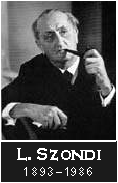













 |
||
 |
 |
|
|
in collaboration with Hans Ziegler and Zula Lakner-Faingold The term Fate Analysis in this context is a generic term used to describe Fate Psychology (its theory) on one hand, and its practical application on the other hand, i.e. Fate Therapy or Fate Analysis in the narrower sense of the term. Fate Analysis as a branch of Depth Psychology Fate Analysis (in a more general sense) is a branch of Depth Psychology. It is founded on the Psychoanalysis of Sigmund Freud and spans a bridge to the complex psychology of C.G. Jung. The relation and importance of these three theories is given by the sequence just mentioned. In practice this means that firstly the emphasis is on the analysis of the personal subconscious, which manifests itself in the symptoms and character features of a person. Only then the familiar subconscious, which expresses itself in the different forms of choice of a person, becomes the center of attention and finally the collective unconscious, the language of which are the symbols, can be treated. Besides this integrative intention, which bridges the three schools, Fate Analysis has complemented depth psychology by the following developments, which are part of its fundamental framework: Essential features of Fate Psychology The drive or need system
A drive is a biopsychic phenomenon, which goes
back to radicals, i.e. to the roots which condition and maintain
human existence. These root factors cannot be measured on a time
scale, they are always present in human experience and behavior,
and their contents are not specific, which means they vary in
their manifestations (Szondi 1972, 25). The importance of the drive system lies in the possibility of attributing psychic phenomenon and also primal fantasies,
The theory of the ego Fate psychology makes a distinction between the Drive ego and the Pontifex ego. The Drive ego with the four functions projection, inflation, introjection and negation is given collectively, yet modified by hereditary-familial factors and also determined individually by the interaction with the environment. It represents the subconscious, emotionally-dynamic part of the ego. The Pontifex ego is defined by three further functions, the transcendental, the integral and participating functions and stands for the more cognitive-valuating part of the ego. These three Pontifex-Ego-functions describe the fundamental steps of a therapeutic process and therefore its efficiency factors. The therapeutic working-through is applied Ego-Psychology. The familial subconscious Fate Analysis complemented the discovery of the personal unconscious of Psychoanalysis with the familial unconscious. At first, Szondi called the contents of this familial unconscious ancestors, which strive to take shape again in the life of a descendant. Thus, ancestors are equivalent to the possible forms of existence of a person, which can also be defined as drive syndroms. The dialectic structure of the psyche or the contradictory drives demand an integrative efficiency. The success or failure of the solution of the antagonistic drives influences the mental equilibrium or its disorders. Even if certain inclinations are inherited, they are nevertheless personally readjustable by conscious determination (Szondi 1952, 28; 1956a, 105). The effect of the familial unconscious is reflected in the different forms of choice of a person (genotropism). In this case it is mainly a question of acts of choice in regard to love and friendship as well as the choice of profession, illnesses and possibly also of the choice of death. The theory of the ancestors and their claims lead to the assumption of a compulsive fate. This compulsive fate, however, can become a personally chosen fate because of the relative freedom of the ego. Practice of fate analysis The following enumeration refers to fate analysis in a narrow sense, that is on the therapy. Preliminary examinations This serves to make a diagnosis and indication, and in general comprises an interview, a curriculum vitae, description of the genogram and a Szondi test. Psychoanalytical phase The personal unconscious is analysed on the basis of Psychoanalysis, including transference and counter-transference, resistance, interpretation, working-through and abstinence. Fateanalytical phase Subsequent to the psychoanalytical phase, the familial unconscious comes into consideration, by the help of passive associative methods and dream interpretation (Szondi 1963, 137 - 138), including transference, counter-transference, resistance, interpretation and working-through. If the contents of the familial unconscious cannot be experienced in a relation with an interlocutor (transference) while they are still symptomatologically relevant, or if they cannot be experienced sufficiently, therapy provokes the experience of the familial contradictory drives or of the claims of the ancestors by active methods. They can be summarized by the term confrontation as a complement to interpretation - as a compliment to interpretation -and according to situation and personality of the therapist they can be applied more or less strongly and intensively. They comprise the repetitive, iterative and shock associative techniques (Szondi 1963, 149-190; Kürsteiner 1987, 195-225) and the confrontation with the possibilities of existence given in the genogram and the Szondi-test. This is followed by an ego-analysis, with the aim of becoming a human being (Szondi 1963, 96). |
 |
 |
c 1996-2000 Leo Berlips, JP Berlips & Jens Berlips, Slavick Shibayev